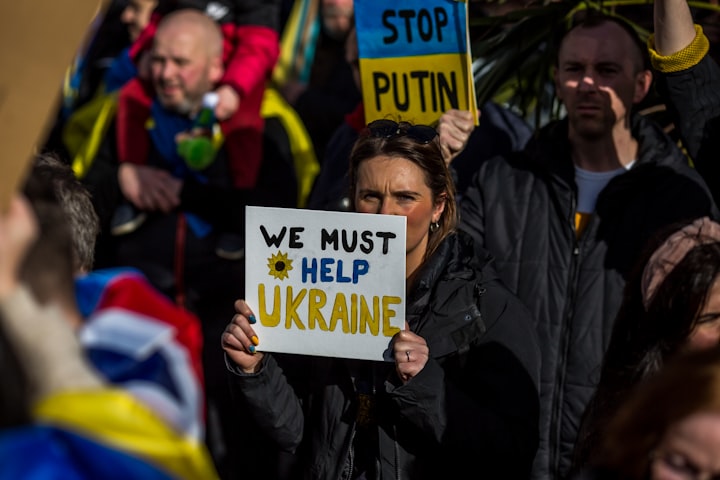UKRAINE LAUNCHES NEW COUNTEROFFENSIVE AGAINST RUSSIA.
Ukraine's Evolving Offensive: A Shifting Battlefield

In the ongoing conflict between Ukraine and Russia, the much-anticipated counteroffensive has encountered significant challenges, leading to a notable shift in Ukraine's original plans.
As the winter snows melted away, the world's attention turned to what had been widely dubbed as Ukraine's "spring offensive." However, taking a closer look, this term might be slightly misleading, as there was no concrete Russian offensive to counter. It's essential to recognize that Russia's winter offensives had largely faltered, leaving Ukraine with a unique opportunity to shape its offensive strategy.
Ukraine's meticulous preparations for the offensive involved the withdrawal of tens of thousands of soldiers from the front lines. These troops underwent rigorous training in NATO-style combined arms warfare across Europe and the United States. It's important to note that a significant proportion of these soldiers were fresh conscripts, yet their training surpassed that of even seasoned Russian counterparts.
At the heart of Ukraine's offensive strategy was the introduction of advanced Western military equipment. After a period of apprehension due to Russia's military posturing and nuclear threats, NATO finally stepped in and supplied Ukraine with a substantial number of Bradley infantry fighting vehicles and Leopard 2 tanks. These modern assets were expected to spearhead Ukraine's spring offensive. Reassurances from figures such as US General Mike Milley bolstered the belief that Ukraine had the necessary tools to execute a successful offensive. However, as the offensive got underway, the actual progress on the ground began to deviate from initial projections.
In the initial weeks of fighting, a media blackout was imposed by Ukraine across the eastern front, inadvertently allowing Russia to gain the upper hand in the propaganda war. Images and videos depicting Ukrainian losses flooded the digital realm, raising concerns about the efficacy of the Western equipment supplied to Ukraine. Vigilant internet sleuths uncovered instances of manipulated visuals, designed to amplify Ukrainian losses, which influenced public sentiment and Western opinions regarding continued support for Ukraine's cause.
Nevertheless, as the conflict entered its second month, it became evident that Ukrainian losses were well within expected parameters. While exact figures remained undisclosed for strategic reasons, it was known that Ukraine had suffered some losses of Leopard 2 tanks, approximately four within the first week of fighting, and possibly around two dozen throughout the conflict. However, these numbers alone fail to capture the full story. What they fail to convey is the resilience of the Ukrainian forces and the efficacy of the Western equipment in protecting crew members during intense battles.
The evolving situation in the conflict highlighted a key fact: while sweeping victories might not have materialized as initially envisioned, Ukraine was making steady and impactful progress. It was successfully reclaiming territory and, perhaps even more significantly, narrowing the logistical gap between itself and Russia. Comparisons to the previous fall counteroffensive, which saw extensive territorial gains, should be considered in the context of the changing dynamics on the ground. Last year's success was partly due to exploiting Russia's unprepared positions, a factor that wasn't as present this time around.
The article underscores that orchestrating an effective counteroffensive during war is a complex endeavor. Ukraine's decision to launch an offensive despite facing well-fortified Russian defenses, artillery disadvantages, and the constant threat of the Russian air force speaks volumes about their resolve and determination. It's a poignant reminder that every meter of gained territory comes at a significant human cost. The sacrifices of the soldiers involved shouldn't be overshadowed by geopolitical analyses or numbers.
As the conflict continued to evolve, Ukraine adjusted its tactics to strategically target Russian artillery and logistics. This shift in approach, while challenging for frontline troops, was an investment in the long-term outcome of the conflict. By gradually eroding Russia's artillery advantage and disrupting their supply lines, Ukraine aimed to mitigate key strengths of the Russian forces.
With Western nations finally recognizing the urgency of the situation, Ukraine's position has markedly improved. The supply of advanced equipment, such as Abrams tanks and F-16s, holds the potential to substantially bolster their military capabilities. France's commitment to providing long-range strike missiles and the possibility of US support for ATACMS missiles underline the Western world's dedication to Ukraine's cause.
In conclusion, while the anticipated counteroffensive encountered hurdles and didn't unfold exactly as predicted, it's imperative to view the ongoing conflict through a comprehensive and evolving lens. Ukraine's strategic adaptations, investment in training and equipment, and unwavering commitment underscore their determination to secure a favorable outcome. As the conflict's dynamics continue to shift, unwavering Western support and decisive actions are paramount in expediting Ukraine's path towards a successful resolution.






Comments
There are no comments for this story
Be the first to respond and start the conversation.